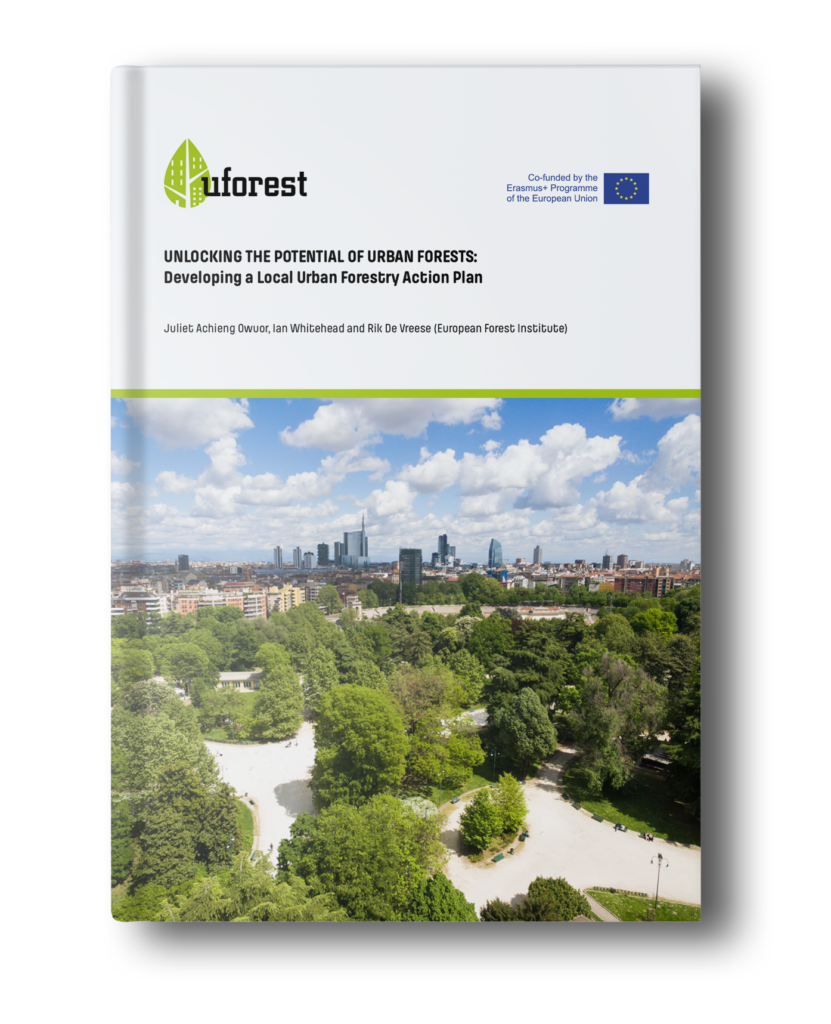A new report by Uforest to help policy- and decision-makers in the development of a local Urban Forestry Action Plan

In recent years, there has been increasing interest in urban forests as an efficient nature-based solution to challenges posed by urbanisation and climate change. Indeed, if single trees provide us with many environmental and health benefits, urban forests can help us to maximise those benefits, by creating a strong green network.
Urban forests are defined as tree-based urban ecosystems consisting of all woodlands, groups of trees, and individual trees located in urban and peri-urban areas. These ecosystems provide enormous environmental, social, and economic benefits to cities and their residents. First, they greatly contribute to cities’ resilience by, for example, regulating storm water run-offs, mitigating the urban heat island effect, and improving biodiversity conservation. Second, urban forests help promote urban dwellers’ health and wellbeing by providing good air quality, a space for physical and social activities, and much more. Third, urban forests also represent a cost-effective solution: for example, the city of Lisbon has assessed that for each €1 invested in urban forestry projects, there is a return of €4,5. Finally, urban forestry solutions can help meet several Sustainable Development Goals (SDGs), such as SDG 15 – Life on Land – and SDG 11 – Sustainable Cities and Communities – as well as goals connected to good health and wellbeing, clean water and sanitation, and zero hunger (Uforest, Blueprint for Innovation in Urban Forestry).
Produced by the Uforest project – of which Etifor is one of the partners – the report “Unlocking the Potential of Urban Forests” provides background and guidelines for the development of an effective Urban Forestry Action Plan. While urban forestry solutions always need some degree of adaptation to local circumstances, the report proposes 7 steps which can be generally applied for the implementation of urban forestry solutions. Each step takes into consideration the multidisciplinary nature of urban forestry, underlining the importance of creating strong partnerships across different sectors to maximise benefits. At the same time, as urban forests should serve the community, it is fundamental to assess the needs and interests of local citizens and engage with them. In fact, involving stakeholders and communities will create a sense of shared vision and ensure the successful implementation, appreciation and, most importantly, use of the urban forest.
These guidelines are aimed mainly at non-specialist audiences, who wish to gain a quick overview of the huge potential of urban forestry to solve environmental, social, and economic challenges in cities. In this sense, the report is mainly addressed to policy- and decision-makers working at the national, local, and European level.
While the full report is only in English, there are 3 short versions translated in the languages of the project’s partners, namely Italian, Romanian and Spanish.
PUBLICATION TITLE
Unlocking the Potential of Urban Forests: Developing a Local Urban Forestry Action Plan
AUTHORS
Juliet Achieng Owuor, Ian Whitehead and Rik De Vreese (European Forest Institute)
COAUTHORS
Jorge Olivar (AGRESTA), Corina Basnou and Florencia Florido (CREAF), Erica Alghisi (ERSAF), Juliet Achieng Owuor, Ian Whitehead and Rik De Vreese (European Forest Institute), Colm O’Driscoll, Ilaria Doimo, Giulia Cecchinato, Arianna Ruberto and Annalice Nicolussi (ETIFOR), Petronela Candrea and Sergiu Florea (Forest Design), Cecil Konijnendijk (Nature Based Solutions Institute), Sofia Paoli and Maria Chiara Pastore (POLIMI), Mary-Lee Rhodes, Siobhán McQuaid and Esmee Kooijman (Trinity College Dublin), Joan Pino (UAB), Iaon Vasile Abrudan, Mihai Nita and Cristina Draghici (University of Brasov)


